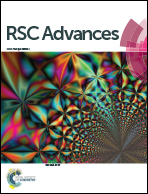Reaction time effect of straw-like MoO3 prepared with a facile, additive-free hydrothermal process
Abstract
The production of molybdenum oxide materials with novel morphology exhibiting unique functions is challenging. Here we investigate the growth process of molybdenum oxide powder with straw-like structures via a facile and additive-free hydrothermal process by varying the reaction time. The crystal structure, morphology and microstructure of samples were characterized to understand the mechanism of formation. Furthermore, optical properties were characterized by ultraviolet-visible diffuse reflectance spectroscopy and color difference meter. The results demonstrate that the as-prepared MoO3 powders possess the same absorption threshold 420 nm and band gap of 3.16 eV. In addition, we found that the nanofibers were peeled off from the prisms and the median state of the product (columnar structures with cavities surrounded by nanofibers) exhibits the most optimal photochromic properties due to the enhanced light harvesting from multiple light reflections and scattering in-between the cavities of the MoO3 columnar structures.


 Please wait while we load your content...
Please wait while we load your content...